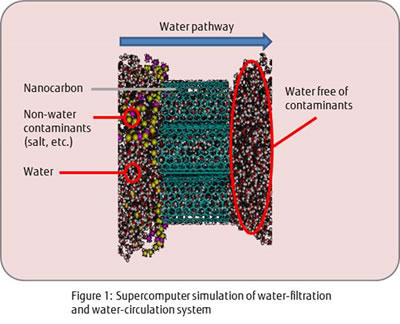Shinshu University deploys supercomputer for R&D into revolutionary water filtration

Enables atomic simulations for material properties design
Fujitsu Limited and Shinshu University have announced Shinshu University's recent decision to deploy a Fujitsu supercomputer system in its R&D facility to newly develop innovative water-filtration and water-circulation systems.
The new system, set to go online in July 2014, will comprise a cluster of 16 FUJITSU Server PRIMERGY RX200 S8 x86 servers, and a single FUJITSU Supercomputer PRIMEHPC FX10.
Shinshu University plans to use the new system to move forward on R&D into revolutionary new water filtration and circulation systems that use nanocarbon and other materials, so as to ensure an adequate supply of water for people around the world.
Background
In the near future, as the earth's population grows, securing supplies of water for households, industry, and agriculture needed to achieve and sustain a comfortable living environment will be an important challenge. To solve this issue, a group led by Shinshu University has established a proposal for an R&D framework to develop a "water filtration and circulation system using revolutionary nanocarbon." This proposal was chosen in March 2013 for the Ministry of Education, Culture, Sports, Science and Technology's (MEXT) "Improvement of international science innovation bases using local resources under industry-university collaboration", and in October 2013 for MEXT and the Japan Science and Technology Agency's Center of Innovation Stream. As a result, Shinshu University is moving forward with the construction of a large-scale research facility at its Nagano Engineering campus in Nagano City, which will focus on following through on this R&D framework to implement it in society.
The new research facility will lead a nationwide organization across Japan that conducts basic research on nanocarbon as a way to use water resources effectively, and to develop systemized technologies for applying that research to water filtration and circulation. This will enable the extraction and circulation of required water from a variety of sources, including seawater and water mixed with oil. With adequate water supplies for people everywhere, this would contribute comfortable living environments and sustainability around the world.
System Overview
To develop an innovative nanocarbon membrane, Shinshu University will use a Fujitsu system that comprises an x86 cluster of PRIMERGY RX200 S8 servers and a PRIMEHPC FX10 supercomputer. This system will be capable of performing complex nanocarbon membrane analyses and simulations that had been difficult with previous levels of processing performance. In addition, the applications that the PRIMEHPC FX10 run are compatible with the K computer, which means that as simulations grow in scale, they can be run on the K computer, as well.
Specifications of the new system are as follows.
| Nodes | 16 |
|---|---|
| Theoretical performance | 6.758 teraflops |
| Total memory capacity | 4-TB |
| Nodes | 12 |
|---|---|
| Theoretical performance | 2.5-teraflops |
| Total memory capacity | 384-GB |

 How to resolve AdBlock issue?
How to resolve AdBlock issue?